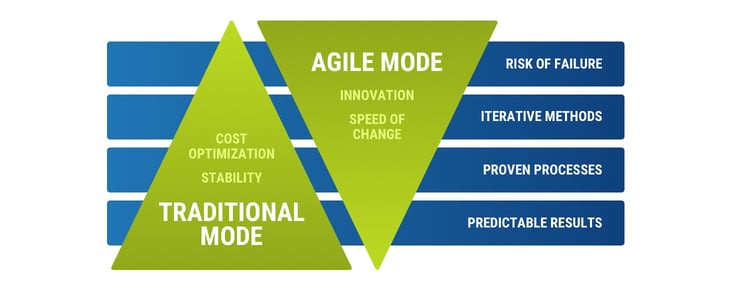Bi-modal IT operation has long been touted by Gartner as a way to help organisations balance their desire for innovation with their need for stability – does DevOps help open that door?
As the New Year’s Eve countdown began in 1999, executives at some of the world’s biggest businesses let loose a sigh of relief. Not only had they avoided the expected maelstrom in the wake of the Asian financial crisis, but global economic conditions were swiftly turning in their favour.
Fast-forward just 17 years and 50% of Fortune 500 companies from the turn of the Millennium no longer exist – unable to adjust to a world now powered by increasingly connected digital technology.
Obviously, history is littered with the skeletons of businesses unable to keep up with change, but now the lifespans of large businesses are shrinking so quickly that c-suite executives believe 40% of current Fortune 500 businesses will be extinct within a decade.
Bi-Modal Operation as A Survival Technique
If the velocity of enterprise extinctions terrifies you, you aren’t alone. Every organisation is locked into the dangerous game of investing increasing time and effort in creating innovative systems to drive profitability in the future, without depriving IT of the resources needed to bring their current systems up to speed.
Gartner Research developed the idea of bi-modal operation to help tackle this issue and better facilitate faster IT evolution within organisations, defining it as:
“…the practice of managing two separate but coherent styles of work: one focused on predictability; the other on exploration.”
Bi-modal operation essentially boils down to having a development team who are comfortable working at two very different speeds, focusing on two very different types of solutions or “modes” that work parallel to each other.

Traditional Mode
Traditional Mode is defined as:
“...optimized for areas that are more predictable and well-understood. It focuses on exploiting what is known, while renovating the legacy environment into a state that is fit for a digital world.”
These projects are all about ensuring your business can operate successfully in the digital world by evolving your IT systems using proven and predictable solutions – with emphasis on ROI.
Agile Mode
Agile Mode is defined as:
“...exploratory, experimenting to solve new problems and optimized for areas of uncertainty.”
These projects are all about ensuring your business can increase agility and speed by evolving your IT systems using innovative and exploratory solutions – with emphasis on differentiation.
Devops & Bi-Modal Operation
To remain competitive, organisations now need to react almost immediately to market changes and put plans into action quickly to capitalise on any emerging digital business opportunities. Essentially, this requires developers to transform business ideas into functionality as soon as possible.
In this respect, DevOps is the perfect partner for bi-modal operations. Many DevOps practices help create a bridge to Agile Mode for many traditional organisations by helping them adopt more flexible techniques and processes – essential for frequent code changes.
Agile Mode operations require a huge degree of connectivity, transparency and collaboration between development, operations and management. This ensures changes to the market are responded to quickly by everyone in your business.
Obviously, this isn’t so simple in practice and requires:
- Management to react quickly to market changes by setting and communicating clear business goals in terms of time to market, quality, and cost.
- Development to transform these goals into functionality, implement a plan of action, communicate the required resources to management and liaise effectively with operations on the launch.
- Operations to communicate launch details with users, facilitate a frictionless launch, listen to user feedback, liaise with development on required troubleshooting and report trends to management.
By adopting a DevOps state-of-mind, you can effectively break down communication barriers and shorten the distance between everyone in a business – providing the pathways needed to achieve Agile Mode operations.
Moving Beyond the Limitations of Bi-Modal Operation with Devops
It’s important to note that while bi-modal operation has correctly identified traditional development practices as unable to support the levels of innovation required in today’s world – it’s based on the false assumption that businesses need to trade reliability for speed.
This is patently wrong.
The DevOps and Agile movements prove you can increase frequency and speed of change, without reducing stability or compromising on quality.
After all, the biggest and most innovative companies in the world like Amazon, Apple and Google haven’t been scared to take risks or respond quickly to market demand, but they also haven’t staked their reputations on shoddy products.
DevOps, when done right, helps you overcome bi-modal operation’s insistence that a high velocity of releases or more innovative products means lower quality. Instead, it works on the idea that quality improves as wasteful processes are removed, leading to higher velocity.
Likewise, DevOps can be successfully applied to Traditional Mode projects, ensuring that highly predictable and familiar solutions can be just as quick or innovative as Agile Mode projects – with more frequent releases enabling greater business responsiveness.
Is Devops The Best of Both "Modes"?
Gartner’s work on bi-modal operation should prove valuable to any enterprise looking to kick-start their digital transformation, and some DevOps techniques facilitate the communication required for Agile Mode projects.
By splitting IT into two separate modes, bi-modal operation ensures businesses aren’t left behind the next wave of innovation, whilst still providing the resources needed to keep operations running profitably in the present.
However, leaders wishing to create a truly significant and lasting impact on IT performance should recognise the limitations of bi-modal operation. Chiefly, the idea that frequent, innovative releases mean a depreciation in quality.
Ideally, all projects should be approached with a mindset that responding to market change quickly can still result in top-quality products – essentially reconciling Traditional Mode and Agile Mode for the best of both worlds.
DevOps techniques facilitate this by creating an organisation where collaboration, transparency and communication between departments are enabled. For businesses to move forward though, they'll have to overcome traditional DevOps challenges and it’s likely a culture shift will be required to instil a sense of urgency at all levels of the organisation.
Click here to download our Navigating DevOps ebook and discover more information about how to start bringing DevOps to life within your business – or simply click the image below.



